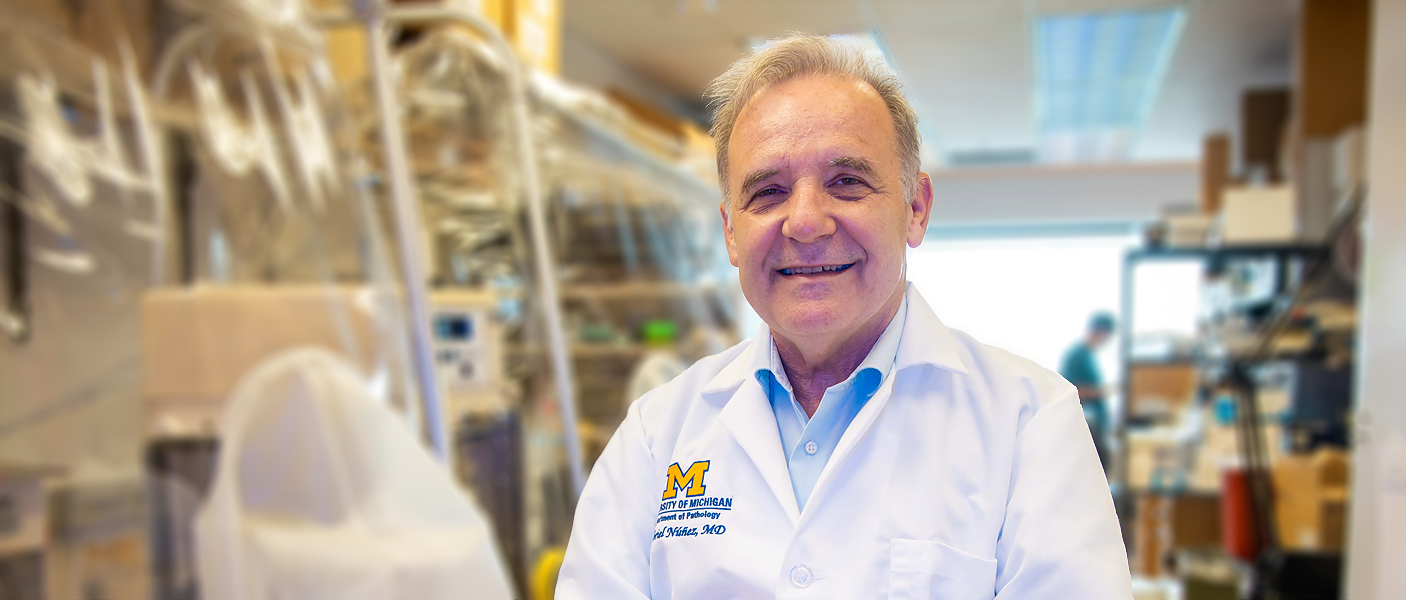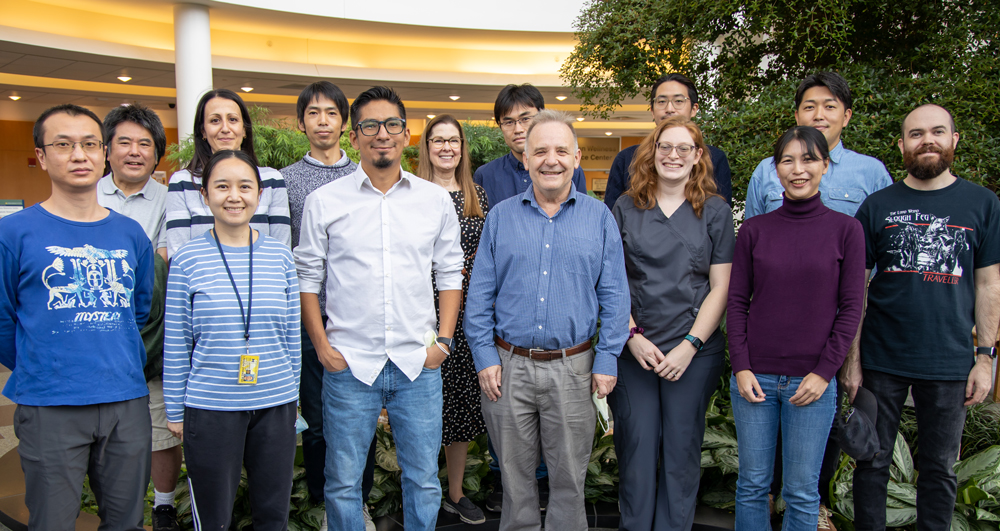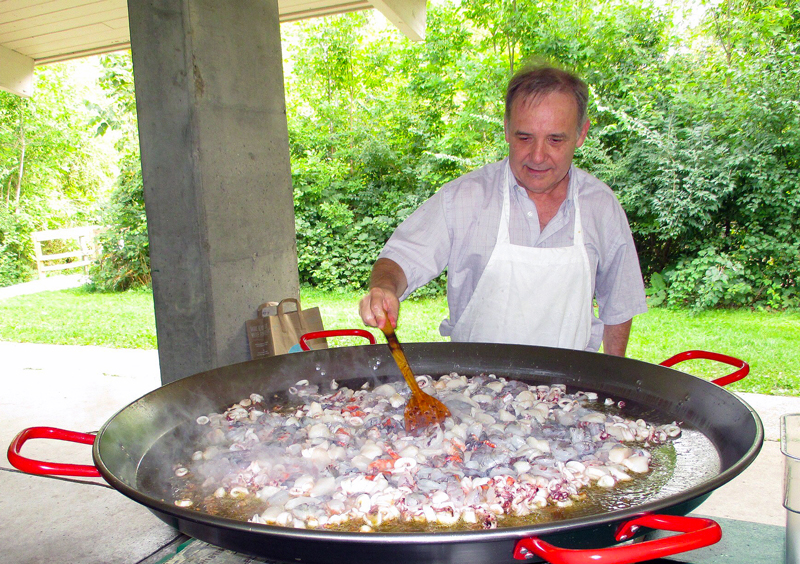

The Centers for Disease Control (CDC) reports that Crohn’s Disease and ulcerative colitis, collectively referred to as Inflammatory Bowel Disease, or IBD, affect approximately 3 million US adults and 80,000 US children, and these numbers are growing. IBD severely impacts the abilities of affected patients to live normal, active lifestyles. The Crohn’s and Colitis Foundation reports that more than 160 genes have been identified that are associated with IBD and that “the gut microbiota (the bacteria and viruses that inhabit the gut) is a key link between genetic susceptibility and IBD onset/progression.” By identifying the microbes that play a role in IBD, it is anticipated that researchers can create medications that specifically address triggers of the disease. One of the world’s foremost researchers in this area is Dr. Gabriel Núñez, the Paul de Kruif Endowed Professor of Experimental Pathology in the Department of Pathology at Michigan Medicine.
In the late 1990s, Núñez’s laboratory discovered Nod-Like Receptors (NLRs) and found that a member of this family, NOD2, is linked to the development of Crohn’s disease. He subsequently found that certain molecular structures in bacteria are recognized by several members of the NLR family in mice including NOD1, NOD2, NLRP3, NLRC4. Núñez and his collaborators found that NOD2 was mutated in patients with Crohn’s disease and activation of NOD2, which senses muramyl dipeptide, a fragment of the bacterial cell wall, was impaired in patients with IBD. His findings were the impetus for other researchers who then expanded upon his discoveries, leading to the more than 160 genes identified as playing a role in IBD.
"I don’t remember exactly how I became interested in this. I didn’t have any family members who were scientists or physicians. I was just interested in biology and medicine as a teenager. "
However, Núñez did not begin his career with a focus on IBD and NLRs. As the oldest of ten children growing up in Seville, Spain, he loved to play soccer and watch Avant Garde films. A particularly influential high school teacher who was passionate about filmmaking introduced him to these films. He took a course on the history and techniques of filmmaking, “and I loved it! I went to London for a camera and started making my own movies,” recalls Núñez. “I didn’t have the money for actors or anything, so I started out making silent movies and thought my career would be in filmmaking. I was also interested in medical research, though. I don’t remember exactly how I became interested in this. I didn’t have any family members who were scientists or physicians. I was just interested in biology and medicine as a teenager. I do remember one night, during my senior year in high school, going to see my parents in their bedroom to tell them I had decided to go to medical school.”
In medical school in Seville, Núñez worked in a transplantation immunology laboratory, conducting research. He met a young woman from Ann Arbor, Michigan who was also studying at Seville. It was this friendship that led to him coming to UM as a visiting medical student. He stayed with her family for a month while he completed his rotation at the old UM hospital. As he was nearing the end of medical school, he met Dr. Peter Stastny at a conference in Rome. Stastny invited him to complete a postdoctoral fellowship in his lab at the University of Texas Health Science Center in Dallas. His postdoctoral research focused on B cells and monoclonal antibodies in transplantation immunology as well as the relationship between the human immune response region (HLA-D) and susceptibility to immune-mediated disease.
A few years later, Núñez moved to Washington University School of Medicine to complete a pathology residency program and to continue his postdoctoral fellowship with Dr. Stanley Korsmeyer. In the Korsmeyer laboratory, he focused on the molecular biology of follicular lymphoma. This led him to Bcl-2 research and the role of apoptosis (cell death) in lymphoma and lymphoid development. During this time, he discovered that Bcl-2 inhibited apoptosis and maintains B-cell memory.
Then, on January 4, 1991, Núñez arrived in Ann Arbor, Michigan once again, this time as an Assistant Professor of Pathology. He had caught the eye of Dr. Peter Ward, former chair of Pathology, who also studied apoptosis. Ward actively recruited Núñez to join the research faculty of the department. “I recruited Gabriel with expectations that he would become a world expert in the area of proteins that allow cells to recognize potentially harmful factors in bacteria, malignant tumors, etc. These studies would have the ability to revolutionize the field of microbiology linked to infectious bacterial diseases,” recalls Ward.
Núñez now had two, very attractive competing offers. He fondly recalled Ann Arbor from his medical student rotation and decided to join the faculty at UM. He soon made many important discoveries related to the Bcl-2 family and their role in apoptosis and cancers. Then in 1998, he discovered NOD1, the first member of the NLR family. A year later, he discovered NOD2 and began to investigate the NLR family’s role in host defense against microbes and their relationship to genetic susceptibility to inflammatory diseases, publishing for the first time on NOD2’s association with susceptibility to Crohn’s disease.

As a result of this discovery, the Núñez lab decided to continue to pursue this avenue of research and changed focus from cell death to host-microbial interactions and inflammatory disease. “This is the area of immunology that is involved in the detection of microbes and fighting against pathogens,” explained Núñez. “In 1998, I wrote three R01 grants at once and I hit a home run; I was awarded all three. By 2000, I was able to make the research focus transition and work full-time on this topic.” More recently, the Núñez laboratory was able to develop a mouse line that had a disease that mimics Crohn’s Disease in humans. He has identified the bacterium in these mice that triggers Crohn’s-like disease. “We just need to identify the same trigger in humans.” For individuals who do not have the genetic mutations that make them susceptible to Crohn’s Disease, the bacterium doesn’t affect them. But for those with mutations, the same bacterium triggers the disease. However, the number of potential microbes and the variety of genetic mutations make the task of identifying the combinations difficult. “It is like finding a needle in a haystack,” says Núñez.
As the laboratory focused on the NLR family, they investigated the role of another member of this family, Cryopyrin, also known as NLRP3. The lab discovered that Cryopyrin forms a multi-protein complex called “the inflammasome”, which contains several proteins, including caspase-1. Cryopryin activates caspase-1, which begins a series of immune responses including the production of interleukin-1β, an essential component in infection resistance when the body encounters bacterial RNA.
In 2008, the laboratory found that Nod1 and Nod2 are important for immune cells to recognize microbial infections and, together with Toll-like receptors, can trigger the body’s defense signaling pathways against infection. Toll-like receptors recognize patterns, such as specific structures in a pathogenic bacterium, and are important for helping the body to recognize pathogens and get the immune response started quickly.
As he continued to pursue this avenue of research, he discovered that mice raised in a germ-free environment responded differently to pathogenic infections than mice raised in a traditional environment. Those raised traditionally had normal amounts and varieties of microbes in their gastrointestinal system, but those raised germ-free did not. When exposed to a bacterium, Citrobacter rodentium, mice with normal guts were able to outcompete this bacterium, but those in a germ-free environment were not able to do so.
He also observed that neonates are much more susceptible to infections than adults. “By colonizing adult germ-free mice with the cecal contents of neonatal and adult mice, we showed that the neonatal microbiota is unable to prevent colonization by two bacterial pathogens that cause mortality in neonates. The lack of colonization resistance occurred when Clostridiales were absent in the neonatal microbiota.” This added more information to his body of knowledge on the importance of specific bacteria essential for keeping the gut healthy and preventing inflammatory processes from occurring.
Recently, the lab explored the mechanism by which the gut microbiota protects us from infection by enteric pathogens. This study discovered that the microbiota consumes dietary amino acids limiting their availability to the pathogen C. rodentium early in the infection process. This finding may help to identify prevention and treatment modalities for enteric pathogens in humans, such as pathogenic E. coli, which functions similarly in people.
“An important aspect of leadership is to foster the development of future leaders at academic institutions."
In addition to conducting research, Núñez is an excellent role model and mentor in the laboratory. He is very proud of his trainees’ achievements and success in academia. His former trainees include one department chair, two vice-chairs, 15 professors, and 18 associate professors. “An important aspect of leadership is to foster the development of future leaders at academic institutions,” he reflected. “During my tenure at the University of Michigan, I have trained more than 65 postdoctoral fellows. Most of them are independent investigators at academic institutions in the United States and around the world.” Dr. Roberta Caruso joined his laboratory as a postdoctoral fellow in 2013 and was promoted to Research Investigator in 2018. She commented, “Dr. Núñez has been an excellent mentor and a great inspiration for me. He has inspired me to pursue my goals with hard work and dedication. Dr. Núñez has shown me the value of honesty, sincerity, and trust in research. The knowledge and wisdom he has imparted to me have been a great help and support throughout my career.”
Dr. Peter Lucas, Professor and Vice Chair, of the Department of Pathology at the University of Pittsburgh School of Medicine, joined the Núñez lab as a research fellow in 1999. Lucas expressed his appreciation, “Gabriel is the kind of mentor that everyone dreams of having–incredibly insightful; brimming with ideas, enthusiasm, and passion; endlessly energetic; joyful and kind. He pushes you to reach your highest potential while giving you freedom, resources, support, and encouragement along the way.” Lucas really appreciated Núñez’s “open door” policy as a trainee. He made himself readily available to his trainees and was always willing to drop whatever he was doing to talk science. “Of all the things I am grateful for from my years in the Núñez lab, I am most indebted to Gabriel for his support and generosity in helping me launch an independent career. Gabriel was incredibly gracious and supportive in allowing me to take a research topic that we developed together in his lab and make it my own.” Lucas has spent the past 20 years developing that topic, focused on chronic inflammation and the development of vascular, metabolic, and neoplastic diseases. Lucas concluded, “Gabriel stands as a shining example of how one can direct the most meaningful and rigorous scientific program while at the same time fostering and building the next generation of scientists who will carry on the mission.” Ward is pleased with Núñez’s success, “Gabriel exceeded all of our expectations and now has worldwide recognition for his ground-breaking discoveries at the University of Michigan.”
 Núñez’s son is now in medical school, and he reports that his textbooks describe his father’s research when covering the unit on IBD, a fact about which he brags to his classmates. “There are a lot of people working on this problem now,” deflected the elder Núñez. With more researchers focused on finding the solution, the future may be bright for patients suffering from IBD. This drives researchers to dedicate their energies to finding the answer. “I am driven by scientific discoveries and the excitement of getting new knowledge. Like other scientists, I love to try to solve the mysteries of life by doing experiments in the lab or in the field.” However, Núñez also emphasized the need for a balanced life if one wishes to be successful in research. “You need to have other interests. Your entire life cannot be about research. I love the symphony, world history, and the arts in general. I love to cook and host paella parties frequently, bringing people from different walks of life together over paella, getting to know each other, and learning from one another. I also often cook for charities to help groups raise money.” This essential work-life balance has allowed Núñez to sustain his 30+ years of research and keeps him energized for the coming years.
Núñez’s son is now in medical school, and he reports that his textbooks describe his father’s research when covering the unit on IBD, a fact about which he brags to his classmates. “There are a lot of people working on this problem now,” deflected the elder Núñez. With more researchers focused on finding the solution, the future may be bright for patients suffering from IBD. This drives researchers to dedicate their energies to finding the answer. “I am driven by scientific discoveries and the excitement of getting new knowledge. Like other scientists, I love to try to solve the mysteries of life by doing experiments in the lab or in the field.” However, Núñez also emphasized the need for a balanced life if one wishes to be successful in research. “You need to have other interests. Your entire life cannot be about research. I love the symphony, world history, and the arts in general. I love to cook and host paella parties frequently, bringing people from different walks of life together over paella, getting to know each other, and learning from one another. I also often cook for charities to help groups raise money.” This essential work-life balance has allowed Núñez to sustain his 30+ years of research and keeps him energized for the coming years.